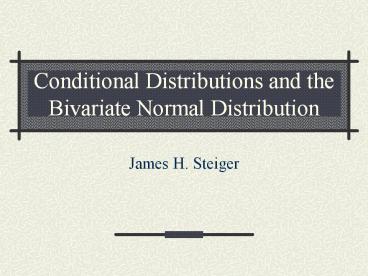Conditional Distributions and the Bivariate Normal Distribution PowerPoint PPT Presentation
Title: Conditional Distributions and the Bivariate Normal Distribution
1
Conditional Distributions and the Bivariate
Normal Distribution
- James H. Steiger
2
Overview
- In this module, we have several goals
- Introduce several technical terms
- Bivariate frequency distribution
- Marginal distribution
- Conditional distribution
- In connection with the bivariate normal
distribution, discuss - Conditional distribution calculations
- Regression toward the mean
3
Bivariate Frequency Distributions
- So far, we have discussed univariate frequency
distributions, which table or plot a set of
values and their frequencies.
X f
4 5
3 4
2 6
1 2
4
Bivariate Frequency Distributions
- We need two dimensions to table or plot a
univariate (1-variable) frequency distribution
one dimension for the value, one dimension for
its frequency.
5
Bivariate Frequency Distributions
- A bivariate frequency distribution presents in a
table or plot pairs of values on two variables
and their frequencies.
6
Bivariate Frequency Distributions
- For example, suppose you throw two coins, X and
Y, simultaneously and record the outcome as an
ordered pair of values. Imagine that you threw
the coin 8 times, and observed the following
(1Head, 0 Tail)
(X,Y) f
(1,1) 2
(1,0) 2
(0,1) 2
(0,0) 2
7
Bivariate Frequency Distributions
- To graph the bivariate distribution, you need a 3
dimensional plot, although this can be drawn in
perspective in 2 dimensions
(X,Y) f
(1,1) 2
(1,0) 2
(0,1) 2
(0,0) 2
8
Bivariate Frequency Distributions
9
Marginal Distributions
- The bivariate distribution of X and Y shows how
they behave together. We may also be interested
in how X and Y behave separately. We can obtain
this information for either X or Y by collapsing
(summing) over the opposite variable. For example
10
Marginal Distribution of Y
11
Conditional Distributions
- The conditional distribution of Y given Xa is
the distribution of Y for only those occasions
when X takes on the value a. - Example The conditional distribution of Y given
X1 is obtained by extracting from the bivariate
distribution only those pairs of scores where
X1, then tabulating the frequency distribution
of Y on those occasions.
12
Conditional Distributions
- The conditional distribution of Y given X1 is
1 2
0 2
13
Conditional Distributions
- While marginal distributions are obtained from
the bivariate by summing, conditional
distributions are obtained by making a cut
through the bivariate distribution.
14
Marginal, Conditional, and Bivariate Relative
Frequencies
- The notion of relative frequency generalizes
easily to bivariate, marginal, and conditional
probability distributions. In all cases, the
frequencies are rescaled by dividing by the total
number of observations in the current
distribution table.
15
Bivariate Continuous Probability Distributions
- With continuous distributions, we plot
probability density. In this case, the resulting
plot looks like a mountainous terrain, as
probability density is registered on a third
axis. The most famous bivariate continuous
probability distribution is the bivariate normal.
Glass and Hopkins discuss the properties of this
distribution in some detail.
16
Bivariate Continuous Probability Distributions
- Characteristics of the Bivariate Normal
Distribution - Marginal Distributions are normal
- Conditional Distributions are normal, with
constant variance for any conditional value. - Let b and c be the slope and intercept of the
linear regression line for predicting Y from X.
17
The Bivariate Normal Distribution
18
Computing Conditional Distributions
- We simply use the formulas
We have two choices Process the entire
problem in the original metric, or Process in Z
score form, then convert to the original metric.
19
Conditional Distribution Problems
- The distribution of IQ for women (X) and their
daughters (Y) is bivariate normal, with the
following characteristics Both X and Y have
means of 100 and standard deviations of 15. The
correlation between X and Y is .60.
20
Conditional Distribution Problems
- First we will process in the original metric.
Here are some standard questions. What are the
linear regression coefficients for predicting Y
from X? They are
21
Conditional Distribution Problems
- What is the distribution of IQ scores for women
whose mothers had an IQ of 145? - The mean follows the linear regression rule
- The standard deviation is
22
Conditional Distribution Problems
- What percentage of daughters of mothers with IQ
scores of 145 will have an IQ at least as high as
their mother?
23
Conditional Distribution Problems
- We simply compute the probability of obtaining a
score of 145 or higher in a normal distribution
with a mean of 127 and a standard deviation of
12. We haveThe area above 1.5 in the
standard normal curve is 6.68.
24
Conditional Distribution Problems
- What are the social implications of this result?

